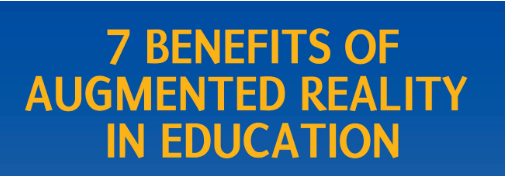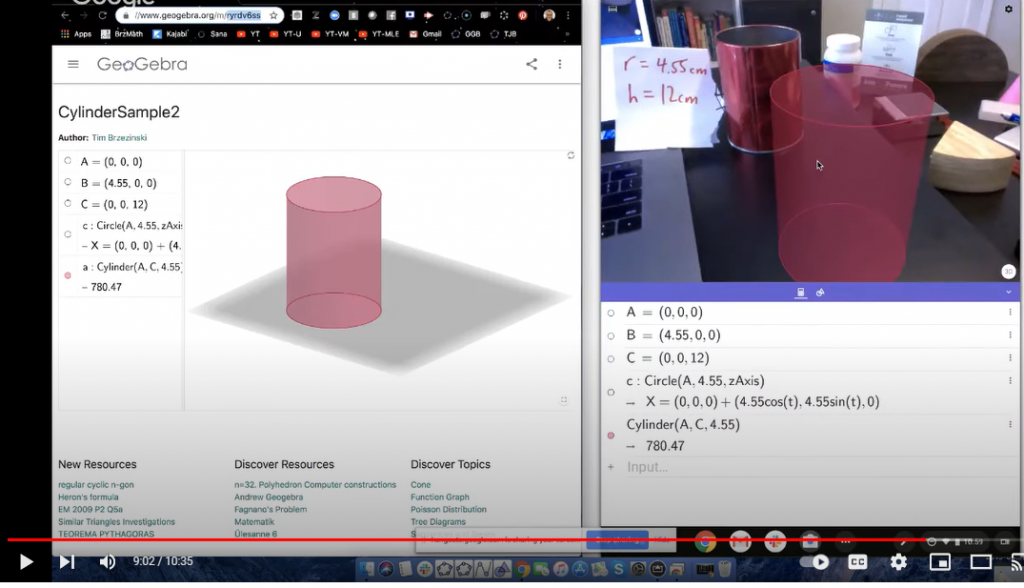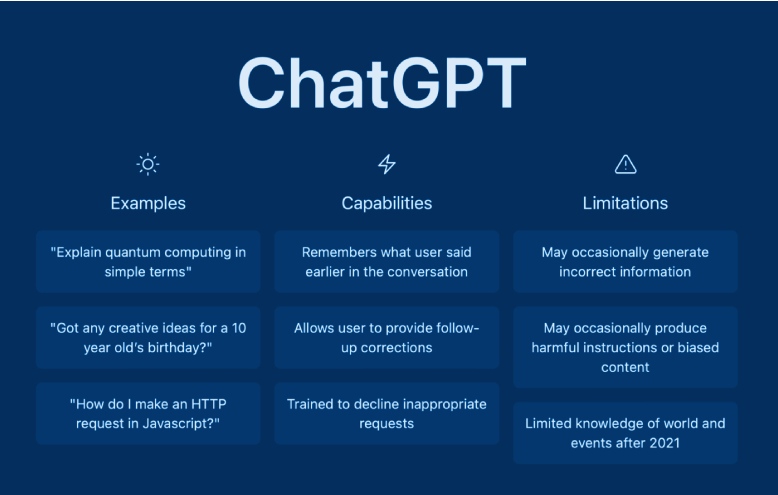THE RESEARCH IS IMPRESSIVE!
GeoGebra, a free and versatile dynamic mathematics software program, has expanded as an Augmented Reality (AR) tool (Kronk, 2018). There are many benefits to AR Technology. Tomaschko and Hohenwarter (2019) cite Bower et al. (2014), Dunleavy & Dede (2014), Hwang (2014), and Wu et al. (2013) as they summarize the following situations where AR can support and enhance learning:
- bridging formal and informal learning
- collaborative learning
- constructivist learning
- context-aware ubiquitous learning
- inquiry-based learning
- games-based learning
- situated learning

AR benefits, more specifically for mathematics education, include
- enhanced visualization, which reduces cognitive load and increases accessibility for learners (Quintero et al., 2015, as cited in Tomaschko & Hohenwarter, 2019)
- active physical learning which is likely to support better spatial relationship skills (Bujak et al., 2013, as cited in Tomaschko & Hohenwarter, 2019)
- increased learner control and autonomy ((Bujak et al., 2013, as cited in Tomaschko & Hohenwarter, 2019), and
- increased ability to support differentiated learning preferences (Tomaschko & Hohenwarter, 2019).
Geogebra’s expansion as an AR tool affords new ways of teaching and learning mathematics. Studies show that AR can
- positively influence cognitive learning (Sotiriou & Bogner, 2008, as cited in Tomaschko & Hohenwarter, 2019)
- improve creativity, critical analysis, and students’ learning outcomes (Bower et al., 2014, as cited in Tomaschko & Hohenwarter, 2019)
- increase students’ interest and motivation (di Serio et al., 2013, as cited by Goff et al., 2018)
- increase engagement (Kamarainen et al., 2013, as cited in Goff et al., 2018) and
- increase content retention (Vincenzi et al., 2003, as cited in Goff et al., 2018).
AR IS ACCESSIBLE!
AR experiences are delivered through common mobile devices such as smartphones and tablets. It is an easily accessible tool that can be integrated into classroom practices to develop learners’ digital skills.

GeoGebra AR allows virtual 3D math objects to be designed and placed into real-world environments, allowing exploration from any angle. Additionally, guided activities lead users to discover math in the real world by taking screenshots from different perspectives. It is interesting, but it is a little underwhelming. There are multiple AR examples of how on Tim Brzezinski’s YouTube channel (https://www.youtube.com/playlist?list=PLtN4Hcxd3KakOEVYp3GnN-xUEj0n89m35), but I do not see them as fitting any objectives for my learners.
A more recent GeoGebra application, Automatically Augmented Reality (AAR), is something that I see as much more valuable, extending the tool’s purpose beyond ‘new technology’ and motivation. This application takes objects from real life and examines them according to their geometry. Using the AAR app, one can take a picture with their phone and examine the underlying shapes in the object, thus linking math, reality, and technology more tightly.

Botana et al. (2019) describe how math promenades could be the source for mathematically examining contextualized images. For students who struggle to ‘see’ the math around them, this is a revolutionary approach where the math is presented to them rather than having to propose the math present. I currently implement a similar project, where students analyze an object for composite shapes. Extending this to include AAR to illustrate and confirm (or deny) their interpretation would be an excellent next step. The AAR app is a valuable tool for learners’ conception both in and outside the classroom.

ChatGPT received the following question and provided the answer shown below.
What is the role of teachers and learners in integrating immersive technology experiences?
When designing educational activities using Augmented Reality (AR), the teacher plays a crucial role in guiding and facilitating the learning process, while the learner takes an active role in exploring and discovering the content.
The teacher should design AR activities that align with the learning objectives and provide clear instructions on how to use the AR tools effectively. They should also provide feedback and support throughout the learning process, as well as scaffold the learner’s understanding by posing questions and offering guidance.
On the other hand, the learner should take an active role in engaging with the AR content and exploring the environment to make connections between the real world and the virtual content. They should also be encouraged to experiment and try different approaches to solving problems, and to reflect on their learning process and outcomes.
Overall, AR provides an opportunity for learners to be more active and engaged in their learning, while the teacher supports and guides their progress. (Chat GPT, 2023)
Familiarizing teachers and learners with new technologies is imperative as they are already infiltrating the workplace to improve worker efficiency and effectiveness. There are benefits and limitations to new technological tools, and exposing students to these tools will help ensure that, as workers, they are comfortable, knowledgeable, and critical when using them
References
Botana, F., Kovacs, Z., Martinez-Sevilla, A., & Recio, T. (2019). Automatically augmented reality with GeoGebra. In T. Prodromou (Ed.), Augmented reality in educational settings (pp. 347-368). Brill. https://brill.com/display/title/55719
Bower, M., Howe, C., McCredie, N., Robinson, A., & Grover, D. (2014). Augmented reality in education – Cases, places and potentials. Educational Media International, 51(1), 1–15.
Brzezinski, T. (2021, July 11). Building and Modeling with Augmented Reality Playlist [Video]. YouTube. https://www.youtube.com/playlist?list=PLtN4Hcxd3KakOEVYp3GnN-xUEj0n89m35
Bujak, K. R., Radu, I., Catrambone, R., MacIntyre, B., Zheng, R., & Golubski, G. (2013). A psychological perspective on augmented reality in the mathematics classroom. Computers and Education, 68, 536–544.
Di Serio, A., Ibanez, M. B., & Kloos, C. D. (2013). Impact of an augmented reality system on students’ motivation for a visual art course. Computers in Education, 68, 586-596.
Dunleavy, M., & Dede, C. (2014). Augmented reality teaching and learning. In J. Spector, M. Merrill, J. Elen, & M. Bishop (Eds.), Handbook of research on educational communications and technology (pp. 735–745). New York, NY: Springer.
Goff, E. E., Mulvey, K. L., Irvin, M. J., & Hartstone-Rose, A. (2018). Applications of augmented reality in informal science learning sites: A review. Journal of Science Education and Technology, 27(5), 433-447.
Hwang, G.-J. (2014). Definition, framework and research issues of smart learning environments – A context-aware ubiquitous learning perspective. Smart Learning Environments, 1(1), 1–14. ISO. (2017). Retrieved from https://www.iso.org/standard/59902.html
Kamarainen, A. M., Metcalf, S., Grotzer, T., Browne, Al, Mazzuca, D., Tutwiler, M. S., & Dede, C. (2013). EcoMOBILE: Integrating augmented reality and probeware with environmental education field trips. Computers in Education, 68, 545-556.
Kronk, H. (2018, September 28). “Everything is a function.” How GeoGebra brough AR to math education. Elearning Inside. https://news.elearninginside.com/geogebra-interview-pt-3-ar/
Mead, C., Buxner, S., Bruce, G., Taylor, W., Semken, S., & Anbar, A. D. (2019). Immersive, interactive virtual field trips promote science learning. Journal of Geoscience Education, 67(2), 131-142.
McPherson, H., Frank, G., Pearce, R., & Hoffman, E. (2021). Virtual Field Trips: Pivoting Cross-Curricular Experiential Learning to an Online Platform. Science Teacher, 88(6), 45-51.
Quintero, E., Salinas, P., González-Mendívil, E., & Ramírez, H. (2015). Augmented reality app for calculus: A proposal for the development of spatial visualization. In E. G. Mendívil, P. G. Ramírez Flores, J. M. Gutiérrez, & E. Ginters (Eds.), International Conference on virtual and augmented reality in education (pp. 301–305).
Sotirious, S., & Bogner, F. X. (2008). Visualizing the invisible: augmented reality as an innovative science education scheme. Advanced Science Letters, 1(1), 114-122.
Tomaschko, M., & Hohenwarter, M. (2019). Augmented reality in mathematics education: The case of GeoGebra AR. In T. Prodromou (Ed.), Augmented reality in educational settings (pp. 325-346). Brill. https://brill.com/display/title/55719
Vincenzi, D. A., Valimont, B. Macchiarella, N., Opalenik, C., Gangadharan, S. N., & Majoros, A. E. (2003). The effectiveness of cognitive elaboration using augmented reality as a training and learning paradigm. In Proceedings of the Human Factors and Ergonomics Society Annual Meeting (Vol 47, pp. 2054-2058, Vol 19). Los Angeles: SAGE Publications Sage.
Wu, H. K., Lee, S. W. Y., Chang, H. Y., & Liang, J. C. (2013). Current status, opportunities and challenges of augmented reality in education. Computers and Education, 62, 41–49.
